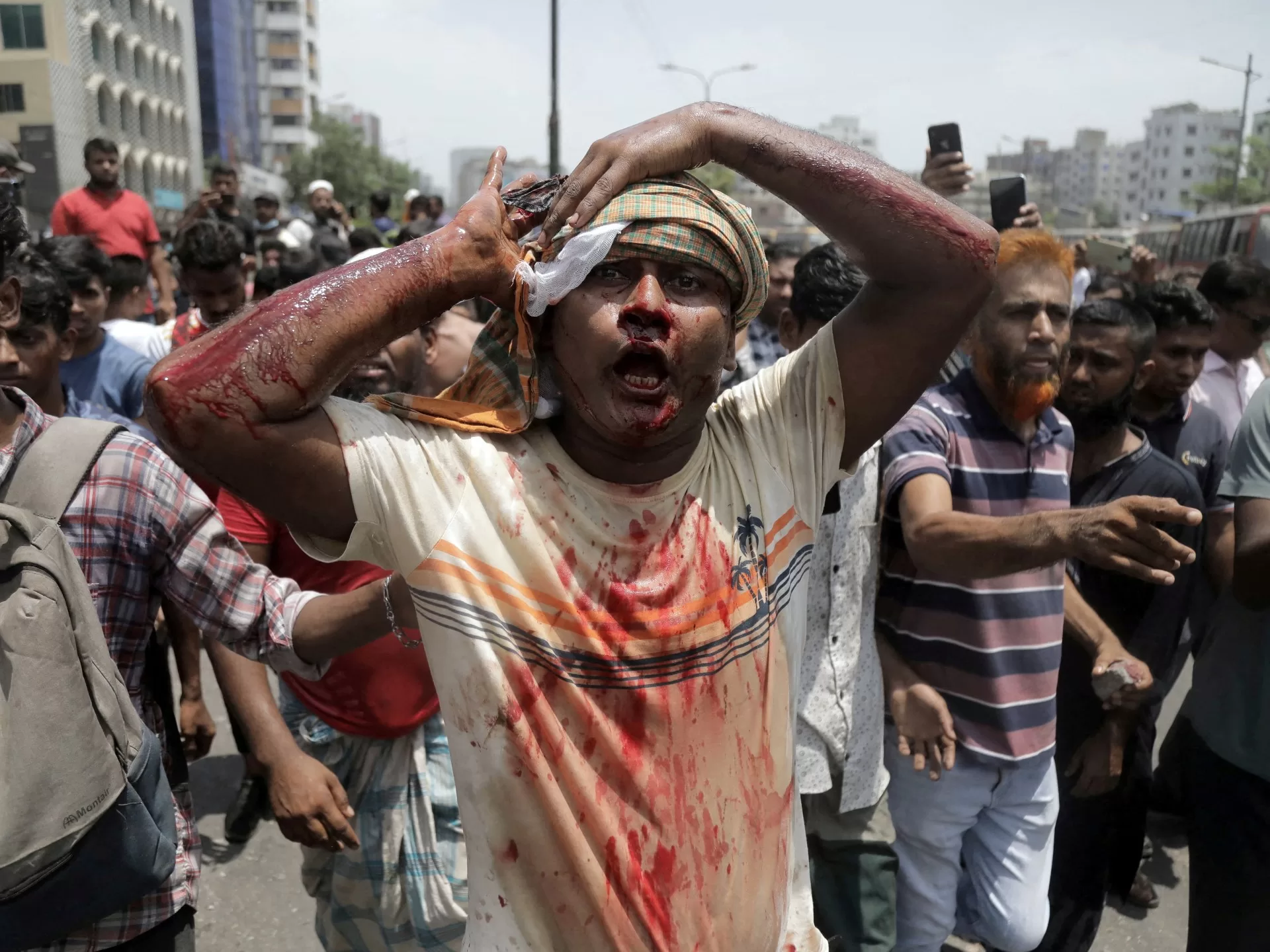Dhaka, Bangladesh — Within the sterile walls of the National Institute of Ophthalmology and Hospital (NIOH) in Bangladesh’s capital Dhaka, a sombre scene unfolds.
Dozens of young men, their faces etched with worry and uncertainty, sit in silent anticipation. Some shield their injured eyes behind dark sunglasses. Others wear white bandages on one or both eyes.
One question hangs in the air: Will these men ever see the world clearly again?
They are victims of pellet injuries — both survivors and reminders of the deadly clashes between protesters seeking job quota reforms and the security forces of Bangladesh that engulfed the nation of 170 million people for nearly two weeks this month.
Among them is Mohammad Anik, a 24-year-old salesperson from Madaripur – a central district some 150km (93 miles) away from Dhaka. “There is a less than 50 percent chance that he [Anik] will get his eyesight back,” said a duty doctor at NIOH who requested anonymity. “There were several injuries in his two eyes and we had tried our best.”
Last Monday, Anik was heading home from work when he got caught in a street clash between protesters and police. Before he could figure out what was happening, a pellet struck his face. He fell to the ground, unconscious and exposed, until bystanders intervened and took him to the hospital.
Now, he finds himself amid the dozens of young men at NIOH, their futures shrouded in darkness.
Hundreds of patients of pellet guns injury
The NIOH has treated nearly 500 patients in the last few days, hailing from various districts including Dhaka, all grappling with severe eye injuries. Hospital records reveal that at least 278 of these individuals also sustained wounds to other parts of their bodies.
Mohammad Shamim, a 10-year-old who worked at a motorcycle workshop, sustained pellet injuries to both eyes during a clash between police and protesters last Friday in the Mirpur area of the capital. Doctors have said he will never fully recover his vision. “My son’s future looks grim. What am I going to do with him?” lamented his father, Mohammad Idris.
NIOH’s director, Golam Mostafa, confirmed that shotgun pellets used during the anti-quota protests were the primary cause of the injuries.
“In cases where the pellet embeds itself in the retina’s centre or is forcefully ejected upon impact, partial blindness becomes the tragic outcome,” he said.
Researchers who looked at pellet injuries to protesters in Indian-administered Kashmir have previously found [PDF] that when fired at close range, the pellets lack sufficient time to disperse, resulting in a concentrated cluster that moves at incredibly high speeds. This concentrated force transforms the pellets into projectiles akin to handgun bullets, capable of piercing deep into soft tissues, particularly the eyes, causing extensive and irreversible damage.
The devastating impact of pellet guns on eyesight hinges on the velocity and distance at which the pellets are fired, the study explained. The severity of these injuries has prompted international condemnation, with Amnesty International calling for a ban on their use for crowd control in Indian-administered Kashmir a few years ago.
Violation of UN-issued guidance
The United Nations has warned against using metal pellets, like those expelled from shotguns, in law enforcement, arguing that they are inherently inaccurate and often violate the principles of necessity and proportionality.
Bangladeshi police and security forces however have resorted to using 12-gauge pump-action shotguns loaded with cartridges containing these very metal pellets, a number of security analysts told Al Jazeera after analysing several photos and footage.
Al Jazeera telephoned and sent text messages to Home Minister Asaduzzaman Khan and several top officials from the police forces but received no response. Salim Mahmud, secretary of information and research of the ruling Awami League party, told Al Jazeera that he had to “check with the police and paramilitary forces” whether “any lethal weapon” was used against the protesters.
Meanwhile, the US-based Human Rights Watch has accused Bangladesh’s security forces of using excessive force during the protests. Their findings reveal the use of live ammunition, tear gas, stun grenades, rubber bullets, and shotgun pellets to disperse demonstrators. Amnesty International has also raised similar concerns.
Those who sustained eye injuries during the recent anti-quota protests, along with their families, claim that the police used indiscriminate force, firing at them without restraint.
Rakibul Ahsan from the southern district of Barisal was part of the protests. A fourth-year statistics student at BM College, Ahsan was on the streets with his classmates last Tuesday when he was shot in both eyes. Doctors have not assured him of a full recovery. “We were protesting for a legitimate cause and were shot at for it. There is no justice here,” Ahsan lamented.
Sumon Mia, a mason from Madaripur who shared a hospital ward with salesman Anik, was also struck by a pellet in his right eye. But unlike Ahsan, and like Anik, he was not involved in the agitation against the government — he was simply heading home from work. Despite a surgery, doctors couldn’t save that eye — his vision is lost.
“My brother wasn’t involved in any protests. Why was he shot? Who will be held accountable for this?” his sister, Lipi Akter, asked.
